"Sea Spider" in the fight against torpedoes
In the Baltic Sea the activity of the naval forces of different countries is always great; the fleets of NATO and Russia are deployed there, and sometimes even Chinese ships come here. Russian and NATO forces are vying for operational space, U.S. Navy ships circling Russian planes at low altitudes, and NATO ships are being pursued by Russian ships. In October 2014, which is considered to be a watershed in NATO-Russia relations, the Swedish Navy pointed to "alien activity underwater", after which for a week they pursued a certain underwater intruder in the Baltic waters, but did not catch anyone. Shallow, limited by the width of the Baltic waters complicate operational actions on the water and under water, but they provide an excellent platform for testing new technologies.
In April 2019, Atlas Elektronik, a marine electronics company and part of the thyssenkrupp Marine Systems (tkMS) technology group, announced the completion of the final test phase of its SeaSpider torpedo torpedo (PTT). According to a statement from Atlas Elektronik, “SeaSpider trials have demonstrated the operability of the entire sensor-operator chain of a vehicle’s anti-torpedo protection system with the ability to detect, classify and localize torpedoes (OKLT).”
The tests were carried out on the Baltic Sea in the Bay of Eckernfjord from a research experimental vessel from the technical center of the German Bundeswehr (WTD - Wehrtechnische Dienststelle 71). A SeaSpider prototype was launched from a surface launcher against threats such as the Toure DM2A3 torpedoes and an autonomous underwater vehicle based on the Mk 37 torpedo. According to Atlas Elektronik, “threats ... were detected and localized using passive and active OKLT tools, and the corresponding data was used to launch SeaSpider. The SeaSpider torpedo seized threats and aimed at the closest point of maximum rapprochement. Successful "interception" - the equivalent closest point of maximum proximity - was confirmed by acoustic and optical means.
Atlas Elektronik added that these tests, as part of a longer testing process, were carried out at the end of the 2017 year; after a comprehensive test evaluation over the course of 2018, the results were approved by the WTD 71 Center.
Torpedo threat
For many years now, the torpedo threat has prevented ships and submarines from walking calmly on the seas. Although almost three 50 years ago, only three ships were sunk in torpedoes, the increased torpedo capabilities make NATO fleets focus their attention on the underwater area.
“At the moment, we see that the threat of submarines and torpedoes is growing,” said Torsten Bochentin, director of development of underwater weapons at Atlas Elektronik. - The standard reaction to areas with a high probability of using torpedoes is “do not enter.” With the growing threat of submarines and torpedoes, currently particularly relevant in marine areas such as the Baltic Sea or the Persian Gulf, “not entering” - in fact, means not acting at all. ”
The development of technology in recent years has increased the capabilities of torpedoes. “We have two big developments,” said Bocentin. “The digital era has finally reached torpedoes.” Thanks to the development of digital intelligence technology, torpedoes have now become smart enough to maintain their own tactical image and classify and respond to contacts. At the same time, simpler torpedoes gained the ability to build their own time-distance diagram using ready-made digital electronics. “Connect with a simple wake guiding device and here you have a torpedo that is not immune to false targets in your hands.”
“The figure also did not pass by the hydroacoustic stations (GAS),” he continued. - If you look at the physical properties of the HAS, the ability to digitally process the signals allows you to fully use the physical potential of the station, as a result, the capabilities of passive sonars have now significantly increased. The sonar capabilities are currently such that false targets and jammers can interfere with torpedoes, but they will nonetheless hit the target. ”
Signal processing in digital ASGs also fits well with the concept of using anti-torpedo torpedoes. “As a supporting technology for the SeaSpider project, it is a kind of partial answer to the question, why didn’t you do this in the 80 of the last century? - noted Bocentin. - Digital technology allows the use of more compact signal processing devices that can be freely programmed to run advanced algorithms. If you compare it with analog electronics or even with hybrid analog-digital systems, it becomes clear that only now in the digital era can we integrate the capabilities necessary for PTT into such a small form factor. ”
Technological paradigms
Bocentin claims that the SeaSpider project aims to create two paradigms of underwater technology. “The first is the operational paradigm when a torpedo threat carries an unforeseen and. therefore, an unacceptable risk. The second paradigm is the usual way of operating submarine weapons with very large efforts spent on logistics, with a very advanced infrastructure of workshops and a large number of well-trained personnel necessary for servicing, transporting, setting up and using the weapons system. This is really what we want to change, ”he added. The company intends to do this by reducing the cost of design, maintenance and logistics, that is, the total cost of ownership. For example, due to the integration of a jet engine into the SeaSpider torpedo and firing of the SeaSpider from the container, which serves both as a transport and launch mechanism. “Containerization,” as an integrated approach, is designed to “provide the customer with what is easy to handle, which does not force him to pay huge sums for additional systems and services”.
Although PTT concepts and technologies have been around for quite some time, Bochentin claims that the enduring nature of the torpedo threat forces them to develop special-purpose PTTs. “The real problem for the PTT is a torpedo pointing towards the wake, and only through a more specialized system can you deal with it. Atlas has been focusing from the very beginning on our special solution to combat torpedoes pointing at wake tracks. ”
The SeaSpider anti-torpedo torpedo is approximately 2 meters long and 0,21 meters in diameter. It consists of 4 compartments: a rear compartment (classified), a jet engine, a compartment with a warhead (if necessary, replaced with a practical warhead) and a guidance compartment, including a homing system based on sonar. The use of solid fuel means that the engine has no moving parts; the superpressure created in the combustion chamber is transformed into draft due to the outflow of gases through the nozzle.
For anti-torpedo protection of submarines (PZP) homing system, operating in active and passive modes, is supplemented by an interception function. Although the detection frequencies of the SeaSpider PTT are not disclosed, the company’s reference data states that “the active ASG frequency was specially chosen for the optimal detection of torpedoes with guidance on the wake stream and to exclude interference with the ship’s sensors”. Since the main objective of the PTT is to combat such torpedoes, its active and passive functionality “is specially designed to be effective against torpedoes in the area of wake-track weakening,” Bochentin noted. “In general, higher frequencies increase the likelihood of a successful torpedo threat.”
Fully digital monitoring and guidance functions are based on an advanced semiconductor microprocessor, including an inertial measurement unit and designed specifically to provide wake torpedoes, and in the case of a PZP - to intercept. SeaSpider is also powered by an OKLT sonar installed on the launch platform.
Although the development of a single SeaSpider single torpedo focuses on providing anti-torpedo protection for surface ships, it is also planned to use it in anti-torpedo protection of submarines. The use of both a single torpedo and a container launcher means that after the surface protection systems for surface ships appear on the market, the emphasis will be shifted to the anti-torpedo defense of submarines and “ideally, the customer will be able to reconfigure the anti-torpedo protection of submarines or surface ships,” said Bocentin.
“As for the torpedo, we are using a remote fuse with backup shock mode. Tests have shown that a direct strike is a separate opportunity, especially outside the wake, against torpedoes that are not guided by the wake track. We don’t need a direct hit, but as a fallback, it is certainly necessary. ”
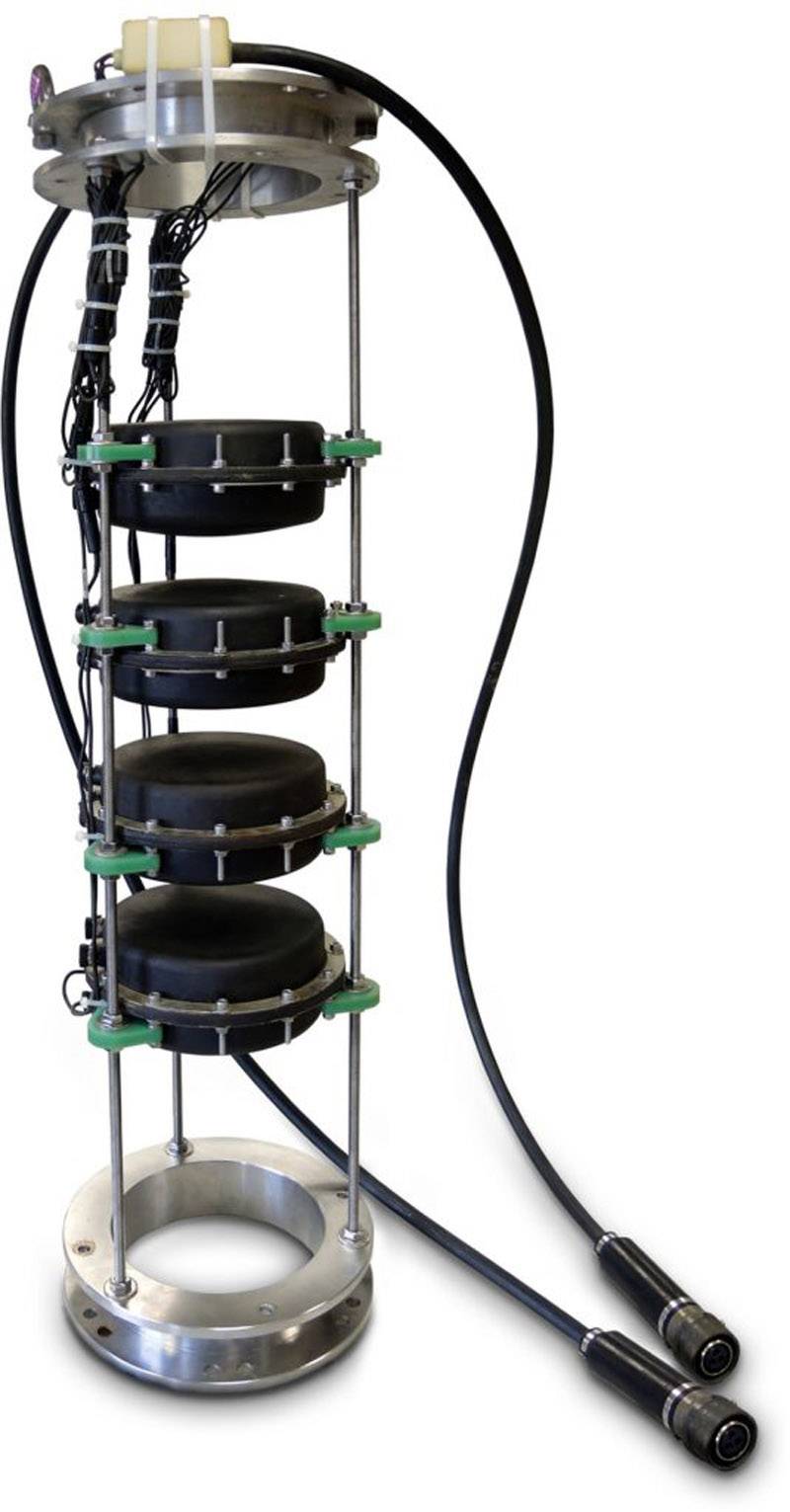
Shallow water tests
A surface ship operating in coastal areas requires capabilities that are optimized for offshore shelf conditions, including shallow water, limited access, uneven bottom, and the effect of proximity of the surface and the seabed on the characteristics of the GAS.
“The Baltic Sea is a standard of the shallow sea in the scenario of underwater hostilities. To be effective in the coastal strip, you must be a standard for the coastal zone, if you are not a standard for the coastal zone, the system will not work there. ” Due to the secrecy of the work, Bocentin could not explain how active and passive sensors deal with coastal conditions. "Any new underwater weapon for the first time, Atlas Elektronik sees real-world conditions in Eckernfjord Bay at a depth of 20 meters. ”
A surface ship operating in coastal areas will need to act quickly and at extremely short distances to protect against torpedoes. According to Bocentin, although previous versions of the SeaSpider had a starting engine for delivering torpedoes from their launch tube to the point of falling into the water as far from the ship as possible, tests in the limited waters of the Baltic Sea revealed the need for "reduced reaction time and attack distance." In this regard, the design has two requirements. First, “You need to deliver SeaSpider into the water as quickly as possible close to the protected platform using a downward-facing launch tube. Secondly, “a very fast reaction of our propulsion is necessary, so that we can have instant dynamic ascent and, therefore, can launch a torpedo even in the shallowest areas”.
SeaSpider is pointing at the attack torpedo with the help of a ship OKLT sonar. As part of the integration of the platform with the anti-torpedo during the tests, special attention was paid to data transmission channels from the OKLT sonar to SeaSpider with the possibility of feedback. An OKLT class system, which is essentially an Atlas experimental towed active sonar with OKLT functionality, detects, classifies and captures a threat before transmitting data to the SeaSpider torpedo ship control unit, which provides it with a set of parameters based on this data and launches. This is what we have successfully done in the now-completed series of tests. ”
There are three options for starting the SeaSpider PTT from the carrier platform: using the local control panel (also known as a torpedo installation computer) located near the launch frame or installed on it; either from the operational cabin using a separate console or by downloading the software to an existing multi-functional console. As for the console concepts in the operational cabin “most likely, any standard console will not be a separate console only for SeaSpider, but will be an integral part of a comprehensive anti-torpedo defense,” said Bocentin. This console also includes an OKLT sonar control system.
Although the SeaSpider torpedo per se is a homing weapon, Atlas is interested in developing an OKLT-class system capable of monitoring target acquisition so that when an OKLT sonar provides reliable data about it, “we could follow the“ shot-aim-shot philosophy "If the probability of hitting the target during the initial capture is evaluated negatively."
When launched, air under pressure in the container pushes the SeaSpider torpedo downward. The launch container itself is located on the launch frame (ideally, it is permanently fixed to the carrier platform), through which power is supplied and data is transmitted.
One of the priorities of the SeaSpider project is the development of the cassette launch principle. A cluster-ready combat-ready weapon allows faster deployment and easier logistics. The company's goal is to certify the entire SeaSpider product with a launch container. Launch containers are designed for transportation in standard sea containers.
The development of a combat-ready torpedo using the cassette principle and the launch frame also means that the number of torpedoes on a ship can vary depending on the need. On larger platforms, “for example, cruisers and destroyers, you will need to distribute the launchers along the length of the ship, on the port and starboard side,” Bochanin noted. Smaller ships with shorter cruising ranges need fewer launchers. However, the minimum number of installations is determined in aggregate by such characteristics as, for example, ship size, maneuverability and cruising range.
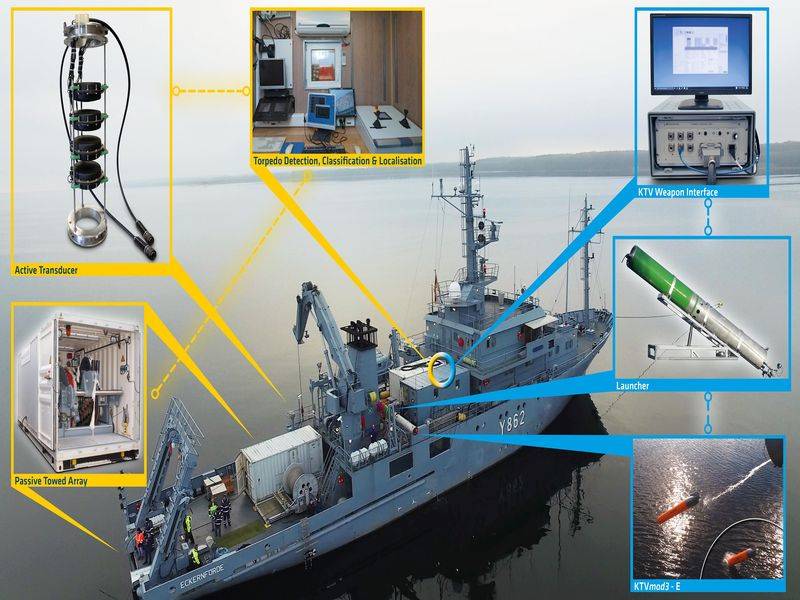
Torpedo Tests
In naval trials ending in 2018, "the SeaSpider anti-torpedo was launched from an immovable platform using conventional enemy torpedoes that actually simulated a dynamic scenario."
The next test cycles, which will be carried out in the next few years, since the initial combat readiness is scheduled for the 2023-2024 years according to the schedule, will include testing the wake guidance system when the SeaSpider fires from a moving platform using a torpedo operating in the wake of this platform. This, according to Bocentin, "will be the main milestone of the program." The next stage of testing should end with the product entering the market.
SeaSpider torpedo readiness
The main step in the direction of the planned readiness for operation in the 2023-2024 year will be the appearance of a starting customer or customers by the deadline planned in this schedule. While several NATO fleets, along with the NATO Industrial Advisory Council, are assessing the requirements, capabilities, and options for anti-torpedo protection of surface ships, Bochentin did not name any customers the company works with. However, the German armed forces today are involved in the development and testing of anti-torpedo torpedoes.
The critical role of a launch customer is to facilitate the adoption of weapons systems. “Some things industry itself cannot do. “We need a fleet as a customer with our powerful research structures to complete the qualifications and certification of the systems being developed.”
In order to strengthen cooperation with a potential start-up customer, Atlas Elektronik decided - with the support of the parent company tkMS - to continue proactive development. Atlas teamed up with Canadian-based Magellan Aerospace under a direct contract to develop, certify and qualify explosives for mass production, as well as use Magellan’s extensive experience in jet engine technology.
"An important stage here is the qualification and certification of explosives." While the development of technology and testing has been carried out to date, the serial version of the standard high-explosive charge requires full certification in accordance with NATO standards (STANAG) for low-sensitivity explosives; All production of this option is part of the certification process. The great efforts and lengthy time needed to obtain such a certificate mean that the development of explosives is the “most important step” on the way to increasing the capabilities of SeaSpider. A key part of the development process in 2019 will be collaboration with Magellan and the start of testing explosive charge components.
Contacts between the two companies were confirmed in a press release issued in April 2019 of the year. It states that "Magellan will lead the design and development of the SeaSpider torpedo rocket engine and warhead, including the design, testing, manufacturing and testing of products for compliance with technical requirements."
Bochentin noted that the technologies developed within the SeaSpider program basically reached the 6 availability level (technology demonstration), and some elements are close to the 7 level (subsystem development). Here, the company focuses on developing special components, for example, sonar algorithms.
Another important element in achieving the initial capabilities and thus another area of focus for the 2019 year is the preparation for modeling the capabilities of the SeaSpider anti-torpedo torpedo. “You can’t just check each variable using the PTT, so you can talk about a two-pronged process,” said Bocentin. “On the one hand, you want to have test data at sea that confirms the simulation.” On the other hand, you want to have capabilities that allow you to go beyond that experience at sea with this simulation. ”
The need for anti-torpedo protection of NATO fleets is steadily growing, as they may face the threat of torpedo attacks in the North Atlantic, the Baltic Sea and the Eastern Mediterranean.
The NATO command publicly noted the activity of Russian submarines. Perhaps the risks here are not just theoretical. For example, in April 2018, British media reported on a Russian diesel-electric submarine of the Kilo class, which, in preparation for attacks on Syria, came too close to American, British and French forces.
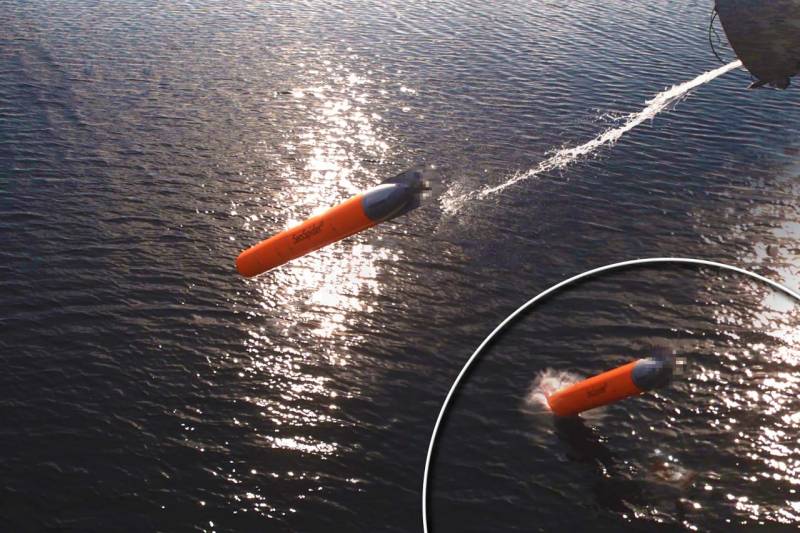


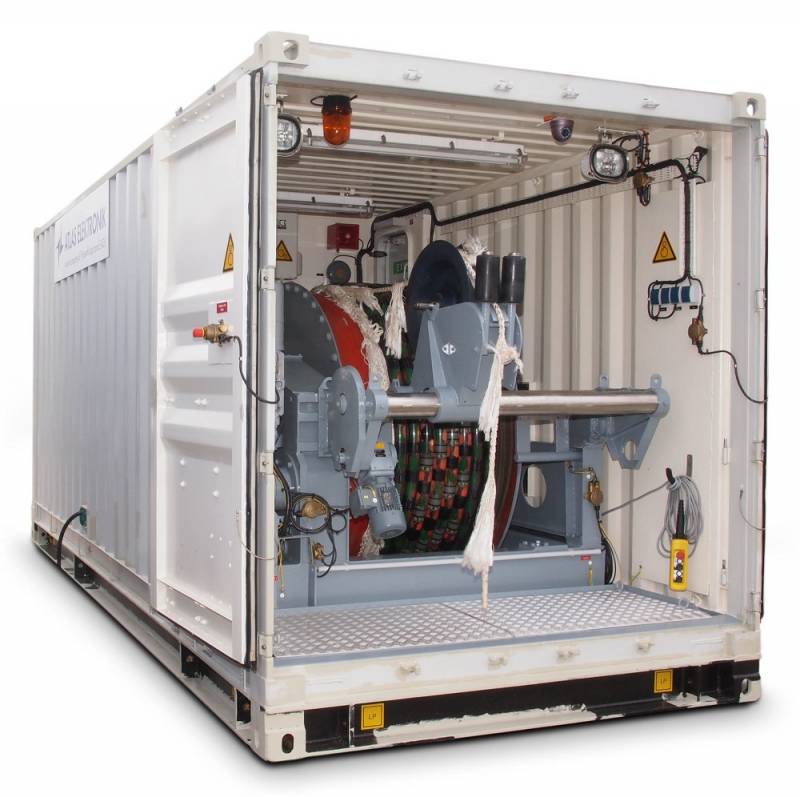
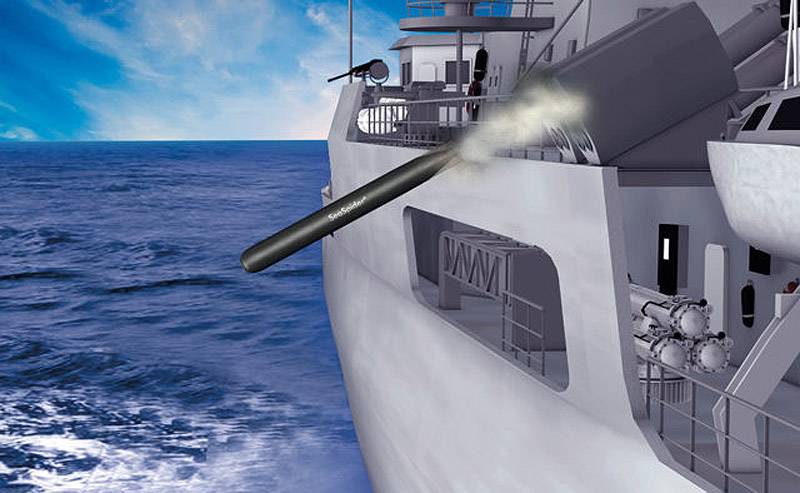
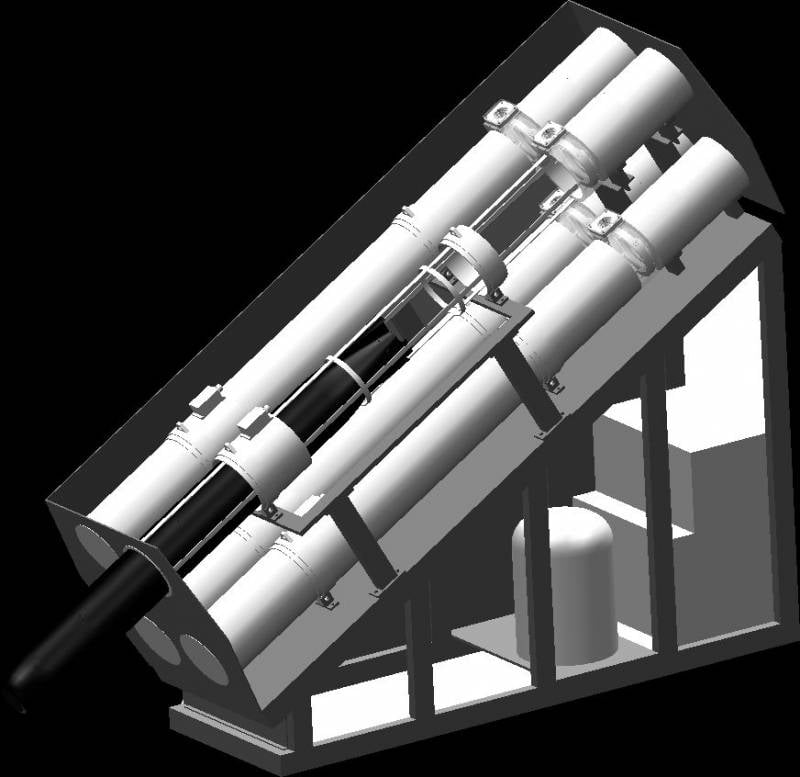
Information